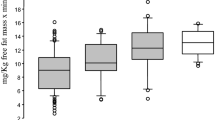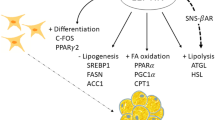Abstract
Purpose
Fibroblast growth factor-21 (FGF-21) is a member of fibroblast growth factor family. Both growth hormone (GH) and FGF-21 take place in the regulation of glucose and lipid metabolism. We aimed to investigate FGF-21 levels in acromegaly which is characterized by excess GH levels and is associated with comorbidities and altered body composition.
Methods
We studied 43 subjects (21 females and 22 males, mean age of 50.0 ± 12.8) with acromegaly. The control group consisted of 40 gender- and age-matched subjects (25 females and 15 males, mean age of 48.8 ± 8.8). Acromegaly patients were classified into two groups; active acromegaly (AA; n = 26) and controlled acromegaly (CA; n = 17). Metabolic, anthropometric and laboratory values of subjects were recorded. FGF-21 level was measured by ELISA assay.
Results
Median FGF-21 levels were significantly higher in acromegaly group compared to control group (85.5 vs. 59.0 pg/mL, p = 0.02, respectively). In the multiple regression model, FPG, A1c, HOMA-IR, glucose intolerance, BMI, visceral fat, hs-CRP, presence of hypertension, dyslipidemia and acromegaly were included as independent variables to explain variability of plasma FGF-21 levels in whole study group. The presence of acromegaly was the only determinant of increased FGF-21 levels in the whole study group (β coefficient = 0.253, p = 0.006).
Conclusion
FGF-21 levels were increased significantly in acromegaly group. Increased FGF-21 levels were significantly and independently associated with the state of acromegaly. Acromegaly may also be a FGF-21 resistance state independent from insulin resistance, glucose intolerance, obesity, hypertension and dyslipidemia.

Similar content being viewed by others
References
Katznelson L, Atkinson JL, Cook DM, Ezzat SZ, Hamrahian AH, Miller KK (2011) American Association of Clinical Endocrinologists Medical Guidelines for clinical practice for the diagnosis and treatment of acromegaly–2011 update: executive summary. Endocr Pract 17(4):636–646
Katznelson L, Laws ER, Melmed SJ, Molitch ME, Murad MH, Utz A, Wass JA (2014) Acromegaly: An Endocrine Society Clinical Practice Guideline. J Clin Endocrinol Metab 99(11):3933–3951
Beenken A, Mohammadi M (2009) The FGF family: biology, pathophysiology and therapy. Nat Rev Drug Discov 8(3):235–253. https://doi.org/10.1038/nrd2792
Kharitonenkov A, Wroblewski VJ, Koester A, Chen YF, Clutinger CK, Tigno XT, Hansen BC, Shanafelt AB, Etgen GJ (2007) The metabolic state of diabetic monkeys is regulated by fibroblast growth factor-21. Endocrinology 148(2):774–781 (Epub 2006 Oct 26)
Zhang X, Yeung DC, Karpisek M, Stejskal D, Zhou ZG, Liu F, Wong RL, Chow WS, Tso AW, Lam KS, Xu A (2008) Serum FGF21 levels are increased in obesity and are independently associated with the metabolic syndrome in humans. Diabetes 57(5):1246–1253
Kim WJ, Kim SS, Lee HC, Song SH, Bae MJ, Yi YS, Jeon YK, Kim BH, Kim YK, Kim IJ (2015) Association between serum fibroblast growth factor 21 and coronary artery disease in patients with type 2 diabetes. J Korean Med Ssci 30(5):586–590
Zhang X, Ibrahimi OA, Olsen SK, Umemori H, Mohammadi M, Ornitz DM (2006) Receptor specificity of the fibroblast growth factor family. The complete mammalian FGF family. J Biol Chem 281(23):15694–15700. https://doi.org/10.1074/jbc.M601252200
Kurosu H, Choi M, Ogawa Y, Dickson AS, Goetz R, Eliseenkova AV, Mohammadi M, Rosenblatt KP, Kliewer SA, Kuro-o M (2007) Tissue-specific expression of betaKlotho and fibroblast growth factor (FGF) receptor isoforms determines metabolic activity of FGF19 and FGF21. J Biol Chem 282(37):26687–26695
Badman MK, Pissios P, Kennedy AR, Koukos G, Flier JS, Maratos-Flier E (2007) Hepatic fibroblast growth factor 21 is regulated by PPARa and is a key mediator of hepatic lipid metabolism in ketotic states. Cell Metab 5(6):426–437. https://doi.org/10.1016/j.cmet.2007.05.002
Wang H, Qiang L, Farmer SR (2008) Identification of a domain within peroxisome proliferator-activated receptor gamma regulating expression of a group of genes containing fibroblast growth factor 21 that are selectively repressed by SIRT1 in adipocytes. Mol Cell Biol 28(1):188–200. https://doi.org/10.1128/MCB.00992-07
Trainer PJ, Drake WM, Katznelson L, Freda PU, Herman-Bonert V, van der Lely AJ, van der Lely AJ, Dimaraki EV, Stewart PM, Friend KE, Vance ML, Besser GM, Scarlett JA, Thorner MO, Parkinson C, Klibanski A, Powell JS, Barkan AL, Sheppard MC, Malsonado M, Rose DR, Clemmons DR, Johannsson G, Bengtsson BA, Stavrou S, Kleinberg DL, Cook DM, Phillips LS, Bidlingmaier M, Strasburger CJ, Hackett S, Zib K, Bennett WF, Davis RJ (2000) Treatment of acromegaly with the growth hormone-receptor antagonist pegvisomant. N Engl J Med 342(16):1171–1177
Shen Y, Ma X, Zhou J, Pan X, Hao Y, Zhou M, Lu Z, Gao M, Bao Y, Jia W (2013) Additive relationship between serum fibroblast growth factor 21 level and coronary artery disease. Cardiovasc Diabetol 12:124. https://doi.org/10.1186/1475-2840-12-124.ORI
American Diabetes Association (2015) Diagnosis and classification of diabetes mellitus. Diabetes Care 38:S8–S16
Akyildiz ZI, Polat S, Yurekli BS, Kocabas GU, Tuluce K, Tuluce SY, Kocabas U, Bozkaya G, Yuksel A, Nazli C (2015) Epicardial fat, body mass index, and triglyceride are independent contributors of serum fibroblast growth factor 21 level in obese premenopausal women. J Endocrinol Invest 38(3):361–366. https://doi.org/10.1007/s40618-014-0185-3 (Epub 2014 Oct 14)
Chen W, Hoo RL, Konishi M, Itoh N, Lee PC, Ye HY, Lam KS, Xu A (2011) Growth hormone induces hepatic production of fibroblast growth factor 21 through a mechanism dependent on lipolysis in adipocytes. J Biol Chem 286(40):34559–34566. https://doi.org/10.1074/jbc.M111.285965 (Epub 2011 Aug 17)
Segerlantz M, Bramnert M, Manhem P, Laurila E, Groop LC (2003) Inhibition of lipolysis during acute GH exposure increases insulin sensitivity in previously untreated GH-deficient adults. Eur J Endocrinol 149(6):511–519
Mai K, Andres J, Biedasek K, Weicht J, Bobbert T, Sabath M, Meinus S, Reinecke F, Möhlig M, Weickert MO, Clemenz M, Pfeiffer AF, Kintscher U, Spuler S, Spranger J (2009) Free fatty acids link metabolism and regulation of the insulin-sensitizing fibroblast growth factor-21. Diabetes 58(7):1532–1538. https://doi.org/10.2337/db08-1775 (Epub 2009 Apr 28)
Mai K, Bobbert T, Groth C, Assmann A, Meinus S, Kraatz J, Andres J, Arafat AM, Pfeiffer AF, Möhlig M, Spranger J (2010) Physiological modulation of circulating FGF21: relevance of free fatty acids and insulin. Am J Physiol Endocrinol Metab 299(1):E126–E130. https://doi.org/10.1152/ajpendo.00020.2010 (Epub 2010 Apr 27)
Brooks NE, Hjortebjerg R, Henry BE, List EO, Kopchick JJ, Berryman DE (2016) Fibroblast growth factor 21, fibroblast growth factor receptor 1, and β-Klotho expression in bovine growth hormone transgenic and growth hormone receptor knockout mice. Growth Horm IGF Res 30–31:22–30. https://doi.org/10.1016/j.ghir.2016.08.003 (Epub 2016 Aug 24)
Berryman DE, List EO, Coschigano KT, Behar K, Kim JK, Kopchick JJ (2004) Comparing adiposity profiles in three mouse models with altered GH signaling. Growth Horm IGF Res 14(4):309–318
Lin Z, Zhou Z, Liu Y, Gong Q, Yan X, Xiao J, Wang X, Lin S, Feng W, Li X (2011) Circulating FGF21 levels are progressively increased from the early to end stages of chronic kidney diseases and are associated with renal function in Chinese. PLoS One 6(4):e18398 (6)
Lundberg J, Höybye C, Krusenstjerna-Hafstrøm T, Bina HA, Kharitonenkov A, Angelin B, Rudling M (2013) Influence of growth hormone on circulating fibroblast growth factor 21 levels in humans. J Intern Med 274(3):227–232. https://doi.org/10.1111/joim.12112 (Epub 2013 Jul 24)
Halupczok-Żyła J, Jawiarczyk-Przybyłowska A, Skrzypski M, Bolanowski M, Strowski MZ (2017) Fibroblast growth factor 21 in patients with acromegaly. Exp Clin Endocrinol Diabetes 125(10):649–654. https://doi.org/10.1055/s-0043-115647 (Epub 2017 Sep 20)
Inagaki T, Lin VY, Goetz R, Mohammadi M, Mangelsdorf DJ, Kliewer SA (2008) Inhibition of growth hormone signaling by the fasting-induced hormone FGF21. Cell Metab 8(1):77–83
Fazeli PK, Misra M, Goldstein M, Miller KK, Klibanski (2010) Fibroblast growth factor-21 may mediate growth hormone resistance in anorexia nervosa. J Clin Endocrinol Metab 95(1):369–374. https://doi.org/10.1210/jc.2009-1730 (Epub 2009 Nov 19)
Berryman DE, List EO, Sackmann-Sala L, Lubbers E, Munn R, Kopchick JJ (2011) Growth hormone and adipose tissue: beyond the adipocyte. Growth Hormon IGF Res 21(3):113–123
Funding
This research did not receive any specific grant.
Author information
Authors and Affiliations
Corresponding author
Ethics declarations
Conflict of interest
The authors have nothing to disclose.
Ethical approval
The study was approved by Ege University Local Ethic Committee. All procedures performed in studies involving human participants were in accordance with the ethical standards of the institutional and/or national research committee and with the 1964 Helsinki declaration and its later amendments or comparable ethical standards.
Informed consent
Written informed consent was obtained from all participants.
Rights and permissions
About this article
Cite this article
Yurekli, B.S., Kutbay, N.O., Aksit, M. et al. Acromegaly is associated with high fibroblast growth factor-21 levels. J Endocrinol Invest 42, 53–60 (2019). https://doi.org/10.1007/s40618-018-0885-1
Received:
Accepted:
Published:
Issue Date:
DOI: https://doi.org/10.1007/s40618-018-0885-1




